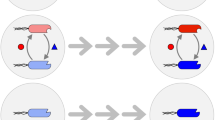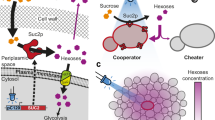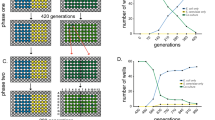Abstract
Understanding the conditions that promote the maintenance of cooperation is a classic problem in evolutionary biology1,2,3,4,5. The essence of this dilemma is captured by the ‘tragedy of the commons’6: how can a group of individuals that exploit resources in a cooperative manner resist invasion by ‘cheaters’ who selfishly use common resources to maximize their individual reproduction at the expense of the group7,8? Here, we investigate this conflict through experimental competitions between isogenic cheater and cooperator strains of yeast with alternative pathways of glucose metabolism9, and by using mathematical models of microbial biochemistry10. We show that both coexistence and competitive exclusion are possible outcomes of this conflict, depending on the spatial and temporal structure of the environment. Both of these outcomes are driven by trade-offs between the rate and efficiency of conversion of resources into offspring that are mediated by metabolic intermediates.
This is a preview of subscription content, access via your institution
Access options
Subscribe to this journal
Receive 51 print issues and online access
$199.00 per year
only $3.90 per issue
Buy this article
- Purchase on Springer Link
- Instant access to full article PDF
Prices may be subject to local taxes which are calculated during checkout




Similar content being viewed by others
References
Axelrod, R. & Dion, D. The further evolution of cooperation. Science 242, 1385–1390 (1988)
Axelrod, R. & Hamilton, W. D. The evolution of cooperation. Science 211, 1390–1396 (1981)
Sachs, J. L., Mueller, U. G., Wilcox, T. P. & Bull, J. J. The evolution of cooperation. Q. Rev. Biol. 79, 135–160 (2004)
Nowak, M. & Sigmund, K. Chaos and the evolution of cooperation. Proc. Natl Acad. Sci. USA 90, 5091–5094 (1993)
Nowak, M., Bonhoeffer, S. & May, R. Spatial games and the maintenance of cooperation. Proc. Natl Acad. Sci. USA 91, 4877–4881 (1994)
Hardin, G. The tragedy of the commons. Science 162, 1243–1248 (1968)
Kreft, J.-U. Biofilms promote altruism. Microbiology 150, 2751–2760 (2004)
Pfeiffer, T., Schuster, S. & Bonhoeffer, S. Cooperation and competition in the evolution of ATP-producing pathways. Science 292, 504–507 (2001)
Otterstedt, K. et al. Switching the mode of metabolism in the yeast Saccharomyces cerevisiae. EMBO Rep. 5, 532–537 (2004)
Pfeiffer, T. & Bonhoeffer, S. Evolution of cross-feeding in microbial populations. Am. Nat. 163, E126–E135 (2004)
Frick, T. & Schuster, S. An example of the prisoner's dilemma in biochemistry. Naturwissenschaften 90, 327–331 (2003)
Elbing, K. et al. Role of hexose transport in control of glycolytic flux in Saccharomyces cerevisiae. Appl. Environ. Microbiol. 70, 5323–5330 (2004)
Bauchop, T. & Elsden, S. R. The growth of microorganisms in relation to their supply of energy. J. Gen. Microbiol. 23, 457–469 (1960)
Ludovico, P., Sousa, M. J., Silva, M. T., Leao, C. & Corte-Real, M. Saccharomyces cerevisiae commits to a programmed cell death process in response to acetic acid. Microbiology 147, 2409–2415 (2001)
Travisano, M. & Velicer, G. J. Strategies of microbial cheater control. Trends Microbiol. 12, 72–78 (2004)
Crespi, B. J. The evolution of social behaviour in microorganisms. Trends Ecol. Evol. 16, 178–183 (2001)
Greig, D. & Travisano, M. The Prisoner's Dilemma and polymorphism in yeast SUC genes. Proc. R. Soc. Lond. B 271 (Suppl.), S25–S26 (2004)
Velicer, G. J. Social strife in the microbial world. Trends Microbiol. 11, 330–337 (2003)
Pfeiffer, T. & Schuster, S. Game-theoretical approaches to studying the evolution of biochemical systems. Trends Biochem. Sci. 30, 20–25 (2005)
van Dijken, J. P. et al. An interlaboratory comparison of physiological and genetic properties of four Saccharomyces cerevisiae strains. Enzyme Microb. Technol. 26, 706–714 (2000)
Acknowledgements
This project was funded by grants from NERC to the Center for Population Biology. I. Gudelj was supported by a NERC-EMS Fellowship. The authors would like to thank C. Godfray for comments and C. Brandon for technical assistance. Author Contributions R.C.M. carried out experimental work and wrote the manuscript. I.G. carried out mathematical modelling.
Author information
Authors and Affiliations
Corresponding author
Ethics declarations
Competing interests
Reprints and permissions information is available at npg.nature.com/reprintsandpermissions. The authors declare no competing financial interests.
Supplementary information
Supplementary Notes
Supplementary Notes nature04672-s1.pdf This file contains Supplementary Figure 1, Supplementary Table 1, Supplementary Note 1 and Supplementary Equation 1. (PDF 145 kb)
Rights and permissions
About this article
Cite this article
MacLean, R., Gudelj, I. Resource competition and social conflict in experimental populations of yeast. Nature 441, 498–501 (2006). https://doi.org/10.1038/nature04624
Received:
Accepted:
Issue Date:
DOI: https://doi.org/10.1038/nature04624
This article is cited by
-
Optogenetic spatial patterning of cooperation in yeast populations
Nature Communications (2024)
-
Coexisting ecotypes in long-term evolution emerged from interacting trade-offs
Nature Communications (2023)
-
Non-linear relationships between density and demographic traits in three Aedes species
Scientific Reports (2022)
-
Successful microbial colonization of space in a more dispersed manner
ISME Communications (2021)
-
Evolution of cooperation in costly institutions exhibits Red Queen and Black Queen dynamics in heterogeneous public goods
Communications Biology (2021)
Comments
By submitting a comment you agree to abide by our Terms and Community Guidelines. If you find something abusive or that does not comply with our terms or guidelines please flag it as inappropriate.



